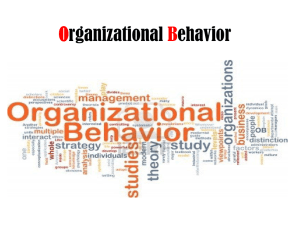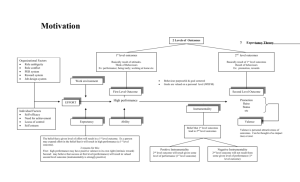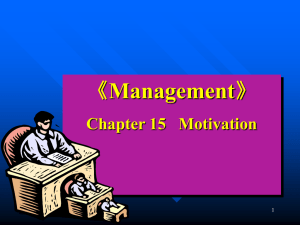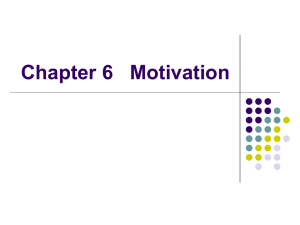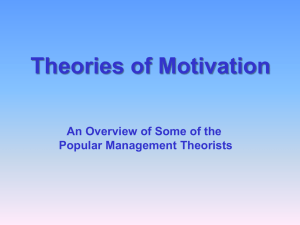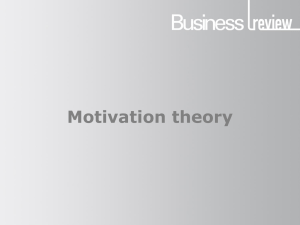Motivation Materials
advertisement
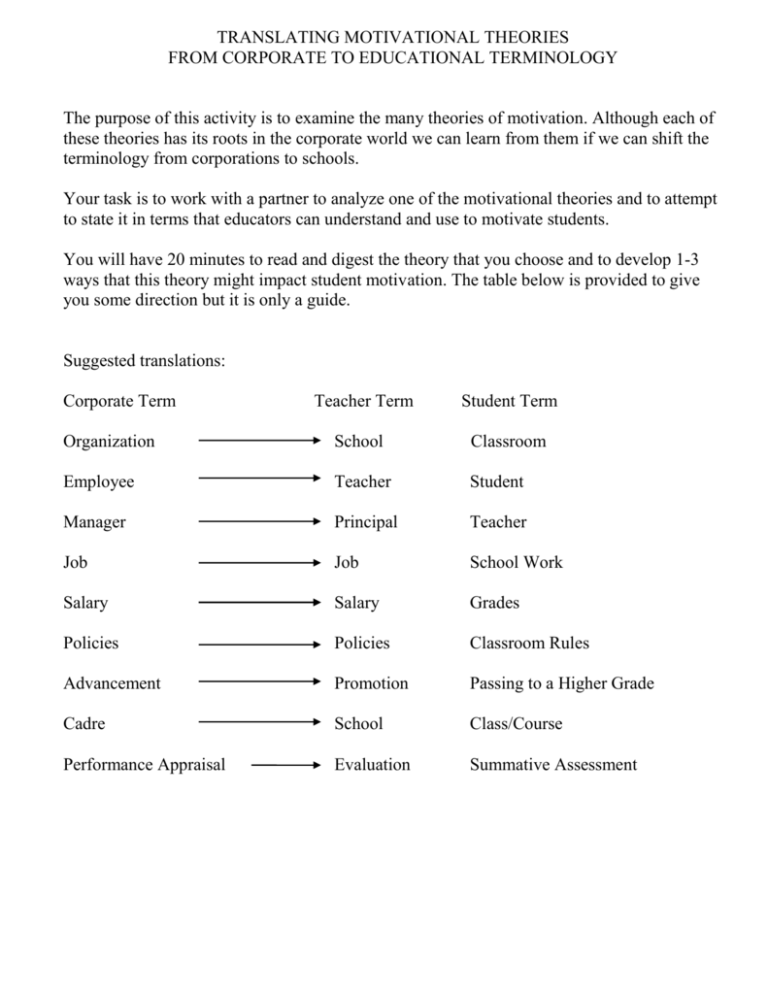
TRANSLATING MOTIVATIONAL THEORIES FROM CORPORATE TO EDUCATIONAL TERMINOLOGY The purpose of this activity is to examine the many theories of motivation. Although each of these theories has its roots in the corporate world we can learn from them if we can shift the terminology from corporations to schools. Your task is to work with a partner to analyze one of the motivational theories and to attempt to state it in terms that educators can understand and use to motivate students. You will have 20 minutes to read and digest the theory that you choose and to develop 1-3 ways that this theory might impact student motivation. The table below is provided to give you some direction but it is only a guide. Suggested translations: Corporate Term Teacher Term Student Term Organization School Classroom Employee Teacher Student Manager Principal Teacher Job Job School Work Salary Salary Grades Policies Policies Classroom Rules Advancement Promotion Passing to a Higher Grade Cadre School Class/Course Performance Appraisal Evaluation Summative Assessment http://www.managementstudyguide.com/classical-theories-of-motivation.htm Student Motivation Theory Maslow’s Hierarchy of Needs Theory Hertzberg’s Two Factor Theory McGregor’s Theory X and Y ERG Theory McLelland’s Theory of Needs Goal Setting Theory Reinforcement Theory Equity Theory Expectancy Theory Premises Impact on Student Motivation Classical Theories of Motivation The motivation concepts were mainly developed around 1950’s. Three main theories were made during this period. These three classical theories are: Maslow’s hierarchy of needs theory Herzberg’s Two factor theory Theory X and Theory Y These theories are building blocks of the contemporary theories developed later. The working mangers and learned professionals till date use these classical theories to explain the concept of employee motivation. Modern Theories of Motivation We all are familiar with the classical theories of motivation, but they all are not empirically supported. As far as contemporary theories of motivation are concerned, all are well supported with evidences. Some of the contemporary / modern theories of motivation are explained below: ERG Theory McClelland’s Theory of Needs Goal Setting Theory Reinforcement Theory Equity Theory of Motivation Expectancy Theory of Motivation Maslow’s Hierarchy of Needs Theory Abraham Maslow is well renowned for proposing the Hierarchy of Needs Theory in 1943. This theory is a classical depiction of human motivation. This theory is based on the assumption that there is a hierarchy of five needs within each individual. The urgency of these needs varies. These five needs are as followsFIGURE: Maslow’s Need 1. Physiological needs- These are the basic needs of air, water, food, clothing and shelter. In other words, physiological needs are the needs for basic amenities of life. 2. Safety needs- Safety needs include physical, environmental and emotional safety and protection. For instance- Job security, financial security, protection from animals, family security, health security, etc. Hierarchy Model 3. Social needs- Social needs include the need for love, affection, care, belongingness, and friendship. 4. Esteem needs- Esteem needs are of two types: internal esteem needs (self- respect, confidence, competence, achievement and freedom) and external esteem needs (recognition, power, status, attention and admiration). 5. Self-actualization need- This include the urge to become what you are capable of becoming / what you have the potential to become. It includes the need for growth and self-contentment. It also includes desire for gaining more knowledge, social- service, creativity and being aesthetic. The self- actualization needs are never fully satiable. As an individual grows psychologically, opportunities keep cropping up to continue growing. According to Maslow, individuals are motivated by unsatisfied needs. As each of these needs is significantly satisfied, it drives and forces the next need to emerge. Maslow grouped the five needs into two categories - Higher-order needs and Lower-order needs. The physiological and the safety needs constituted the lower-order needs. These lower-order needs are mainly satisfied externally. The social, esteem, and self-actualization needs constituted the higher-order needs. These higher-order needs are generally satisfied internally, i.e., within an individual. Thus, we can conclude that during a boom period, the employees lower-order needs are significantly met. Implications of Maslow’s Hierarchy of Needs Theory for Managers As far as the physiological needs are concerned, the managers should give employees appropriate salaries to purchase the basic necessities of life. Breaks and eating opportunities should be given to employees. As far as the safety needs are concerned, the managers should provide the employees job security, safe and hygienic work environment, and retirement benefits so as to retain them. As far as social needs are concerned, the management should encourage teamwork and organize social events. As far as esteem needs are concerned, the managers can appreciate and reward employees on accomplishing and exceeding their targets. The management can give the deserved employee higher job rank / position in the organization. As far as self-actualization needs are concerned, the managers can give the employees challenging jobs in which the employees’ skills and competencies are fully utilized. Moreover, growth opportunities can be given to them so that they can reach the peak. The managers must identify the need level at which the employee is existing and then those needs can be utilized as push for motivation. Limitations of Maslow’s Theory It is essential to note that not all employees are governed by same set of needs. Different individuals may be driven by different needs at same point of time. It is always the most powerful unsatisfied need that motivates an individual. The theory is not empirically supported. The theory is not applicable in case of starving artist as even if the artist’s basic needs are not satisfied, he will still strive for recognition and achievement. Herzberg’s Two-Factor Theory of Motivation In 1959, Frederick Herzberg, a behavioural scientist proposed a two-factor theory or the motivator-hygiene theory. According to Herzberg, there are some job factors that result in satisfaction while there are other job factors that prevent dissatisfaction. According to Herzberg, the opposite of “Satisfaction” is “No satisfaction” and the opposite of “Dissatisfaction” is “No Dissatisfaction”. FIGURE: Herzberg’s view of satisfaction and dissatisfaction Herzberg classified these job factors into two categoriesa. Hygiene factors- Hygiene factors are those job factors which are essential for existence of motivation at workplace. These do not lead to positive satisfaction for long-term. But if these factors are absent / if these factors are non-existent at workplace, then they lead to dissatisfaction. In other words, hygiene factors are those factors which when adequate / reasonable in a job, pacify the employees and do not make them dissatisfied. These factors are extrinsic to work. Hygiene factors are also called as dissatisfiers or maintenance factors as they are required to avoid dissatisfaction. These factors describe the job environment / scenario. The hygiene factors symbolized the physiological needs which the individuals wanted and expected to be fulfilled. Hygiene factors include: Pay- The pay or salary structure should be appropriate and reasonable. It must be equal and competitive to those in the same industry in the same domain. Company Policies and administrative policies- The company policies should not be too rigid. They should be fair and clear. It should include flexible working hours, dress code, breaks, vacation, etc. Fringe benefits- The employees should be offered health care plans (mediclaim), benefits for the family members, employee help programmes, etc. Physical Working conditions- The working conditions should be safe, clean and hygienic. The work equipments should be updated and well-maintained. Status- The employees’ status within the organization should be familiar and retained. Interpersonal relations-The relationship of the employees with his peers, superiors and subordinates should be appropriate and acceptable. There should be no conflict or humiliation element present. Job Security- The organization must provide job security to the employees. b. Motivational factors- According to Herzberg, the hygiene factors cannot be regarded as motivators. The motivational factors yield positive satisfaction. These factors are inherent to work. These factors motivate the employees for a superior performance. These factors are called satisfiers. These are factors involved in performing the job. Employees find these factors intrinsically rewarding. The motivators symbolized the psychological needs that were perceived as an additional benefit. Motivational factors include: Recognition- The employees should be praised and recognized for their accomplishments by the managers. Sense of achievement- The employees must have a sense of achievement. This depends on the job. There must be a fruit of some sort in the job. Growth and promotional opportunities- There must be growth and advancement opportunities in an organization to motivate the employees to perform well. Responsibility- The employees must hold themselves responsible for the work. The managers should give them ownership of the work. They should minimize control but retain accountability. Meaningfulness of the work- The work itself should be meaningful, interesting and challenging for the employee to perform and to get motivated. Limitations of Two-Factor Theory The two factor theory is not free from limitations: 1. The two-factor theory overlooks situational variables. 2. Herzberg assumed a correlation between satisfaction and productivity. But the research conducted by Herzberg stressed upon satisfaction and ignored productivity. 3. The theory’s reliability is uncertain. Analysis has to be made by the raters. The raters may spoil the findings by analyzing same response in different manner. 4. No comprehensive measure of satisfaction was used. An employee may find his job acceptable despite the fact that he may hate/object part of his job. 5. The two factor theory is not free from bias as it is based on the natural reaction of employees when they are enquired the sources of satisfaction and dissatisfaction at work. They will blame dissatisfaction on the external factors such as salary structure, company policies and peer relationship. Also, the employees will give credit to themselves for the satisfaction factor at work. 6. The theory ignores blue-collar workers. Despite these limitations, Herzberg’s TwoFactor theory is acceptable broadly. Implications of Two-Factor Theory The Two-Factor theory implies that the managers must stress upon guaranteeing the adequacy of the hygiene factors to avoid employee dissatisfaction. Also, the managers must make sure that the work is stimulating and rewarding so that the employees are motivated to work and perform harder and better. This theory emphasize upon jobenrichment so as to motivate the employees. The job must utilize the employee’s skills and competencies to the maximum. Focusing on the motivational factors can improve work-quality. Theory X and Theory Y In 1960, Douglas McGregor formulated Theory X and Theory Y suggesting two aspects of human behaviour at work, or in other words, two different views of individuals (employees): one of which is negative, called as Theory X and the other is positive, so called as Theory Y. According to McGregor, the perception of managers on the nature of individuals is based on various assumptions. Assumptions of Theory X An average employee intrinsically does not like work and tries to escape it whenever possible. Since the employee does not want to work, he must be persuaded, compelled, or warned with punishment so as to achieve organizational goals. A close supervision is required on part of managers. The managers adopt a more dictatorial style. Many employees rank job security on top, and they have little or no aspiration/ ambition. Employees generally dislike responsibilities. Employees resist change. An average employee needs formal direction. Assumptions of Theory Y Employees can perceive their job as relaxing and normal. They exercise their physical and mental efforts in an inherent manner in their jobs. Employees may not require only threat, external control and coercion to work, but they can use self-direction and self-control if they are dedicated and sincere to achieve the organizational objectives. If the job is rewarding and satisfying, then it will result in employees’ loyalty and commitment to organization. An average employee can learn to admit and recognize the responsibility. In fact, he can even learn to obtain responsibility. The employees have skills and capabilities. Their logical capabilities should be fully utilized. In other words, the creativity, resourcefulness and innovative potentiality of the employees can be utilized to solve organizational problems. Thus, we can say that Theory X presents a pessimistic view of employees’ nature and behaviour at work, while Theory Y presents an optimistic view of the employees’ nature and behaviour at work. If correlate it with Maslow’s theory, we can say that Theory X is based on the assumption that the employees emphasize on the physiological needs and the safety needs; while Theory X is based on the assumption that the social needs, esteem needs and the self-actualization needs dominate the employees. McGregor views Theory Y to be more valid and reasonable than Theory X. Thus, he encouraged cordial team relations, responsible and stimulating jobs, and participation of all in decision-making process. Implications of Theory X and Theory Y Quite a few organizations use Theory X today. Theory X encourages use of tight control and supervision. It implies that employees are reluctant to organizational changes. Thus, it does not encourage innovation. Many organizations are using Theory Y techniques. Theory Y implies that the managers should create and encourage a work environment which provides opportunities to employees to take initiative and self-direction. Employees should be given opportunities to contribute to organizational well-being. Theory Y encourages decentralization of authority, teamwork and participative decision making in an organization. Theory Y searches and discovers the ways in which an employee can make significant contributions in an organization. It harmonizes and matches employees’ needs and aspirations with organizational needs and aspirations. ERG Theory of Motivation To bring Maslow’s need hierarchy theory of motivation in synchronization with empirical research, Clayton Alderfer redefined it in his own terms. His rework is called as ERG theory of motivation. He re-categorized Maslow’s hierarchy of needs into three simpler and broader classes of needs: Existence needs- These include need for basic material necessities. In short, it includes an individual’s physiological and physical safety needs. Relatedness needs- These include the aspiration individual’s have for maintaining significant interpersonal relationships (be it with family, peers or superiors), getting public fame and recognition. Maslow’s social needs and external component of esteem needs fall under this class of need. Growth needs- These include need for self-development and personal growth and advancement. Maslow’s self-actualization needs and intrinsic component of esteem needs fall under this category of need. The significance of the three classes of needs may vary for each individual. Difference between Maslow Need Hierarchy Theory and Alderfer’s ERG Theory ERG Theory states that at a given point of time, more than one need may be operational. ERG Theory also shows that if the fulfillment of a higher-level need is subdued, there is an increase in desire for satisfying a lower-level need. According to Maslow, an individual remains at a particular need level until that need is satisfied. While according to ERG theory, if a higher- level need aggravates, an individual may revert to increase the satisfaction of a lower- level need. This is called frustration- regression aspect of ERG theory. For instance- when growth need aggravates, then an individual might be motivated to accomplish the relatedness need and if there are issues in accomplishing relatedness needs, then he might be motivated by the existence needs. Thus, frustration/aggravation can result in regression to a lower-level need. While Maslow’s need hierarchy theory is rigid as it assumes that the needs follow a specific and orderly hierarchy and unless a lower-level need is satisfied, an individual cannot proceed to the higher-level need; ERG Theory of motivation is very flexible as he perceived the needs as a range/variety rather than perceiving them as a hierarchy. According to Alderfer, an individual can work on growth needs even if his existence or relatedness needs remain unsatisfied. Thus, he gives explanation to the issue of “starving artist” who can struggle for growth even if he is hungry. Implications of the ERG Theory Managers must understand that an employee has various needs that must be satisfied at the same time. According to the ERG theory, if the manager concentrates solely on one need at a time, this will not effectively motivate the employee. Also, the frustration- regression aspect of ERG Theory has an added effect on workplace motivation. For instance- if an employee is not provided with growth and advancement opportunities in an organization, he might revert to the relatedness need such as socializing needs and to meet those socializing needs, if the environment or circumstances do not permit, he might revert to the need for money to fulfill those socializing needs. The sooner the manager realizes and discovers this, the more immediate steps they will take to fulfill those needs which are frustrated until such time that the employee can again pursue growth. McClelland’s Theory of Needs David McClelland and his associates proposed McClelland’s theory of Needs / Achievement Motivation Theory. This theory states that human behaviour is affected by three needs Need for Power, Achievement and Affiliation. Need for achievement is the urge to excel, to accomplish in relation to a set of standards, to struggle to achieve success. Need for power is the desire to influence other individual’s behaviour as per your wish. In other words, it is the desire to have control over others and to be influential. Need for affiliation is a need for open and sociable interpersonal relationships. In other words, it is a desire for relationship based on co-operation and mutual understanding. The individuals with high achievement needs are highly motivated by competing and challenging work. They look for promotional opportunities in job. They have a strong urge for feedback on their achievement. Such individuals try to get satisfaction in performing things better. High achievement is directly related to high performance. Individuals who are better and above average performers are highly motivated. They assume responsibility for solving the problems at work. McClelland called such individuals as gamblers as they set challenging targets The individuals who are motivated by power have a strong urge to be influential and controlling. They want that their views and ideas should dominate and thus, they want to lead. Such individuals are motivated by the need for reputation and self-esteem. Individuals with greater power and authority will perform better than those possessing less power. Generally, managers with high need for power turn out to be more efficient and successful managers. They are more determined and loyal to the organization they work for. Need for power should not always be taken negatively. It can be viewed as the need to have a positive effect on the organization and to support the organization in achieving it’s goals. The individuals who are motivated by affiliation have an urge for a friendly and supportive environment. Such individuals are effective performers in a team. These people want to be liked by others. The manager’s ability to make decisions is hampered if they have a high affiliation need as they prefer to be accepted and liked by others, and this weakens their objectivity. Individuals having high affiliation needs prefer working in an environment providing greater personal interaction. Such people have a need to be on the good books of all. They generally cannot be good leaders. Goal Setting Theory of Motivation 1960’s , Edwin Locke put forward the Goal-setting theory of motivation. This theory states that goal setting is essentially linked to task performance. It states that specific and challenging goals along with appropriate feedback contribute to higher and better task performance. In simple words, goals indicate and give direction to an employee about what needs to be done and how much efforts are required to be put it. The important features of goal setting theory are as follows: The willingness to work towards attainment of goal is main source of job motivation. Clear, particular and difficult goals are greater motivating factors than easy, general and vague goals. Specific and clear goals lead to greater output and better performance. Unambiguous, measurable and clear goals accompanied by a deadline for completion avoids misunderstanding. Goals should be realistic and challenging. This gives an individual a feeling of pride and triumph when he attains them, and sets him up for attainment of next goal. The more challenging the goal, the greater is the reward generally and the more is the passion for achieving it. Better and appropriate feedback of results directs the employee behaviour and contributes to higher performance than absence of feedback. Feedback is a means of gaining reputation, making clarifications and regulating goal difficulties. It helps employees to work with more involvement and leads to greater job satisfaction. Employees’ participation in goal is not always desirable. Participation of setting goal, however, makes goal more acceptable and leads to more involvement. Goal setting theory has certain eventualities such as: a. Self-efficacy- Self-efficacy is the individual’s self-confidence and faith that he has potential of performing the task. Higher the level of self-efficacy, greater will be the efforts put in by the individual when they face challenging tasks. While, lower the level of self-efficacy, less will be the efforts put in by the individual or he might even quit while meeting challenges. b. Goal commitment- Goal setting theory assumes that the individual is committed to the goal and will not leave the goal. The goal commitment is dependent on the following factors: i. Goals are made open, known and broadcasted. ii. Goals should be self-set by the individual rather than designated. iii. Individual’s set goals should be consistent with the organizational goals and vision. Advantages of Goal Setting Theory Goal setting theory is a technique used to raise incentives for employees to complete work quickly and effectively. Goal setting leads to better performance by increasing motivation and efforts, but also through increasing and improving the feedback quality Limitations of Goal Setting Theory At times, the organization goals are in conflict with the managerial goals. Goal conflict has a detrimental effect on the performance if it motivates incompatible action drift. Very difficult and complex goals stimulate riskier behaviour If the employee lacks skills and competencies to perform actions essential for the goal then the goal-setting can fail and lead to undermining or performance. There is no evidence to prove that goal-setting improves job satisfaction. Reinforcement Theory of Motivation __________________________________________________________________________ Reinforcement theory of motivation was proposed by BF Skinner and his associates. It states that individual’s behaviour is a function of its consequences. It is based on “law of effect”, i.e, individual’s behaviour with positive consequences tends to be repeated, but individual’s behaviour with negative consequences tends not to be repeated. Reinforcement theory of motivation overlooks the internal state of individual, i.e., the inner feelings and drives of individuals are ignored by Skinner. This theory focuses totally on what happens to an individual when he takes some action. Thus, according to Skinner, the external environment of the organization must be designed effectively and positively so as to motivate the employee. This theory is a strong tool for analyzing controlling mechanism for individual’s behaviour. However, it does not focus on the causes of individual’s behaviour . The managers use the following methods for controlling the behaviour of the employees: Positive Reinforcement- This implies giving a positive response when an individual shows positive and required behaviour. For example - Immediately praising an employee for coming early for job. This will increase probability of outstanding behaviour occurring again. Reward is a positive reinforcer, but not necessarily. If and only if the employees’ behaviour improves, reward can said to be a positive reinforcer. Positive reinforcement stimulates occurrence of a behaviour. It must be noted that more spontaneous is the giving of reward, the greater reinforcement value it has. Negative Reinforcement- This implies rewarding an employee by removing negative / undesirable consequences. Both positive and negative reinforcement can be used for increasing desirable / required behaviour. Punishment- It implies removing positive consequences so as to lower the probability of repeating undesirable behaviour in future. In other words, punishment means applying undesirable consequence for showing undesirable behaviour. For instance - Suspending an employee for breaking the organizational rules. Punishment can be equalized by positive reinforcement from alternative source. Extinction- It implies absence of reinforcements. In other words, extinction implies lowering the probability of undesired behaviour by removing reward for that kind of behaviour. For instance - if an employee no longer receives praise and admiration for his good work, he may feel that his behaviour is generating no fruitful consequence. Extinction may unintentionally lower desirable behaviour. Implications of Reinforcement Theory Reinforcement theory explains in detail how an individual learns behaviour. Managers who are making attempt to motivate the employees must ensure that they do not reward all employees simultaneously. They must tell the employees what they are not doing correct. They must tell the employees how they can achieve positive reinforcement. Equity Theory of Motivation The core of the equity theory of motivation is the principle of balance and equity. As per this motivation, an individual’s motivation level is correlated to his perception of equity, fairness and justice practiced by the management. The higher the individuals perception of fairness, the greater the motivation level and vice versa. While evaluating fairness, the employee compares the job input (in terms of contribution) to outcome (in terms of compensation) and also compares the same with that of another peer of equal cadre/category. The D/I ratio (output - input ratio) is used to make such a comparison. EQUITY THEORY Ratio Comparison Perception O/I a < O/I b Under-rewarded (Equity Tension) O/I a = O/I b Equity O/I a > O/I b Over-rewarded (Equity Tension) Negative Tension state: Equity is perceived when this ration is equal. While if this ration is unequal, it leads to “equity tension”. J. Stacey Adams called this a negative tension state which motivates him to do something right to relieve this tension. A comparison has been made between 2 workers A and B to understand this point. Referents: The four comparisons an employee can make have been termed as “referents according to Goodman. The referent chosen is a significant variable in equity theory. These referents are as follows: Self-inside: An employee’s experience in a different position inside his present organization. Self-outside: An employee’s experience in a situation outside the present organization. Other-inside: Another employee or group of employees inside the employee’s present organization. Other-outside: Another employee or employees outside the employee’s present organization. Change in input (e.g. Don’t overexert) An employee might compare himself with his peer within the present job in the current organization or with his friend/peer working in some other organization or with the past jobs held by him with others. An employee’s choice of the referent will be influenced by the appeal of the referent and the employee’s knowledge about the referent. Moderating Variables: The gender, salary, education and the experience level are moderating variables. Individuals with greater and higher education are more informed. Thus, they are likely to compare themselves with the outsiders. Males and females prefer same sex comparison. It has been observed that females are paid typically less than males in comparable jobs and have less salary expectations than males for the same work. Thus, a woman employee that uses another woman employee as a referent tends to lead to a lower comparative standard. Employees with greater experience know their organization very well and compare themselves with their own colleagues, while employees with less experience rely on their personal experiences and knowledge for making comparisons. Choices: The employees who perceive inequity and are under negative tension can make the following choices: Change their outcome (Produce quantity output and increasing earning by sacrificing quality when piece rate incentive system exist) Choose a different referent Quit the job Change self perception (For instance - I know that I’ve performed better and harder than everyone else.) Change perception of others (For instance - Jack’s job is not as desirable as I earlier thought it was.) Assumptions of the Equity Theory The theory demonstrates that the individuals are concerned both with their own rewards and also with what others get in their comparison. Employees expect a fair and equitable return for their contribution to their jobs. Employees decide what their equitable return should be after comparing their inputs and outcomes with those of their colleagues. Employees who perceive themselves as being in an inequitable scenario will attempt to reduce the inequity either by distorting inputs and/or outcomes psychologically, by directly altering inputs and/or outputs, or by quitting the organization. Expectancy Theory of Motivation The expectancy theory was proposed by Victor Vroom of Yale School of Management in 1964. Vroom stresses and focuses on outcomes, and not on needs unlike Maslow and Herzberg. The theory states that the intensity of a tendency to perform in a particular manner is dependent on the intensity of an expectation that the performance will be followed by a definite outcome and on the appeal of the outcome to the individual. The Expectancy theory states that employee’s motivation is an outcome of how much an individual wants a reward (Valence), the assessment that the likelihood that the effort will lead to expected performance (Expectancy) and the belief that the performance will lead to reward (Instrumentality). In short, Valence is the significance associated by an individual about the expected outcome. It is an expected and not the actual satisfaction that an employee expects to receive after achieving the goals. Expectancy is the faith that better efforts will result in better performance. Expectancy is influenced by factors such as possession of appropriate skills for performing the job, availability of right resources, availability of crucial information and getting the required support for completing the job. Instrumentality is the faith that if you perform well, then a valid outcome will be there. Instrumentality is affected by factors such as trust in the people who decide who receives what outcome, the simplicity of the process deciding who gets what outcome, and clarity of relationship between performance and outcomes. Thus, the expectancy theory concentrates on the following three relationships: Effort-performance relationship: What is the likelihood that the individual’s effort be recognized in his performance appraisal? Performance-reward relationship: It talks about the extent to which the employee believes that getting a good performance appraisal leads to organizational rewards. Rewards-personal goals relationship: It is all about the attractiveness or appeal of the potential reward to the individual. Vroom was of view that employees consciously decide whether to perform or not at the job. This decision solely depended on the employee’s motivation level which in turn depends on three factors of expectancy, valence and instrumentality. Advantages of the Expectancy Theory It is based on self-interest individual who want to achieve maximum satisfaction and who wants to minimize dissatisfaction. This theory stresses upon the expectations and perception; what is real and actual is immaterial. It emphasizes on rewards or pay-offs. It focuses on psychological extravagance where final objective of individual is to attain maximum pleasure and least pain. Limitations of the Expectancy Theory The expectancy theory seems to be idealistic because quite a few individuals perceive high degree correlation between performance and rewards. The application of this theory is limited as reward is not directly correlated with performance in many organizations. It is related to other parameters also such as position, effort, responsibility, education, etc. Implications of the Expectancy Theory The managers can correlate the preferred outcomes to the aimed performance levels. The managers must ensure that the employees can achieve the aimed performance levels. The deserving employees must be rewarded for their exceptional performance. The reward system must be fair and just in an organization. Organizations must design interesting, dynamic and challenging jobs. The employee’s motivation level should be continually assessed through various techniques such as questionnaire, personal interviews, etc.
